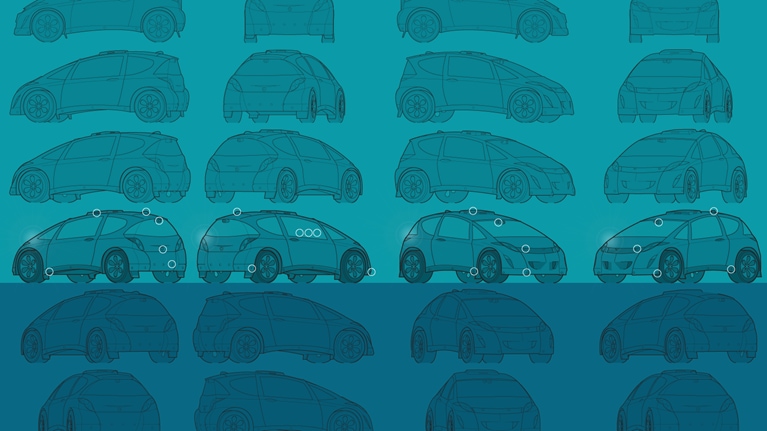Several surface-transport industries have consolidated vigorously over the past few decades. North America had 38 class-one railroads in 1978; today it has just seven. This transformation had a substantial effect on the industry (exhibit). In 1979, the top ten carriers in the less-than-truckload (LTL) industry held 49 percent of the market; in 2012, they had 75 percent. Yet an important part of the transportation sector remains surprisingly fragmented: the full-truckload (TL) industry, which remains anybody’s game. From 2002 to 2015, the share of its top six carriers increased by a paltry six percentage points, to just 20 percent.

Could substantial change be on the way? That’s certainly possible. In April 2017, Knight Transportation and Swift Transportation agreed to merge, in a deal with a combined enterprise value of more than $6 billion. These and a couple of smaller deals—for example, Heartland Express bought Interstate Distributor in July for $113 million—have drawn mixed reactions: some but not all observers see them as the first moves in a wave of change.1 The share price of both companies rose when the Knight–Swift transaction was announced, an oddity2 suggesting that investors felt very positive about it. Yet the expected synergies ($150 million over three years) represent just 2.5 percent of its value, well below some of the numbers in the deals that transformed the LTL and rail industries.
Stay current on your favorite topics
The expected synergies may seem meager, but there could be a deeper logic at work. For several reasons, TL has traditionally been less susceptible to consolidation than other transport industries. One is an absence of fixed costs. Rail and LTL bear tremendous expenses for rail networks and distribution hubs. TL has nothing comparable; the barriers to entry are miniscule, as the extraordinary number of private TL carriers—32,000 in 2012—clearly attests. Intermediaries help even the smallest companies to find shipments. Switching costs for customers are very low—in an industry plagued by poor pricing behavior, they can easily move to cheaper competitors. And if work is slow, some owner–operators find it reasonable to take jobs at (or below) cost rather than sit idle at home.
Finally, all of the mom-and-pop companies, as well as a surprising number—28—of the top 100, are privately or family owned. Some of the founders are nearing retirement, and some of the second-generation owners are also ready to move on, but they would have to be persuaded to let go.
The digital disruptors
Since the structural challenges remain firmly in place, why are some companies merging? In our view, the answer is probably the forces of digitization that are already taking hold in the industry, as well as those still to come. In this article, we’ll explore two of the former and two of the latter. Today, new technologies can improve network usage, and e-commerce has disrupted retailing, one of TL’s most important customers. Tomorrow, new tools that can disrupt the way TL companies sell their services will become increasingly important, and looking further ahead, the industry awaits the advent of autonomous trucks. Each development will probably benefit large truckers more than small ones. Together, these four digital disruptors will go a long way toward shaping the industry’s future—and possibly its structure as well.
Digital disruptor 1: Enhanced and optimized network capabilities
First, novel information-technology tools could create both economies of scale for larger players and barriers to entry for smaller ones. In particular, telematics, sophisticated algorithms to adjust routing and dispatching in real time, and advanced analytics could optimize the biggest and most complex TL networks.
In the past, that was hard to do. Recently, however, a big operator identified the benefits of installing telematics equipment across its entire fleet of some 8,000 vehicles. The technology required an investment of more than $2.5 million, and the annual data-reporting cost was $1.5 million, but the new system cut annual fuel costs by 16 percent, or nearly $60 million, and realized savings of $500,000 by eliminating manual maintenance logs. Telematics has also helped to improve the work habits of drivers and to reduce claims costs, idle-driving time (by 20 to 40 percent), unnecessary and unauthorized driving, and the number of crashes.
Would you like to learn more about our Travel, Logistics & Transport Infrastructure Practice?
In all of these ways, even the slightest optimization gains will make the most complex networks far more effective and increase their value. Over time, carriers that adopt telematics will have lower operating costs than smaller carriers, which will have difficulty competing with this new level of efficiency.
Digital disruptor 2: E-commerce and last-mile delivery
Meanwhile, insourcing by e-commerce giants (such as Amazon) and the establishment of fulfillment hubs by omnichannel retailers (for instance, Best Buy, Target, and Walmart) are fundamentally changing demand for trucking, particularly last-mile networks. Although most of these companies have their own fleets, they often use third parties when demand peaks.
So e-commerce is a second force that could make scale more important in the TL industry. Large players—Alibaba, Amazon, Walmart, and the like—prefer to partner with large TL companies that have sizable networks, since the need to manage multiple carriers increases complexity. As e-commerce comes to account for a higher and higher percentage of total B2B and B2C sales, and customers increasingly expect same-day delivery, in- and outbound logistics will move closer to them. What’s more, the e-commerce giants want greater control over their supply chains and inventory levels, and that too would make them prefer to deal with fewer and larger TL companies.
To meet the supply-chain requirements of the e-commerce giants, TL carriers must therefore have the national footprint needed to haul inventory from ports directly to e-commerce warehouses while maintaining high service levels. The largest carriers may enjoy the best position to capture that business. Demographic trends could also promote this evolution. Since World War II, population density and urbanization have steadily increased in the United States. The e-commerce giants and retailers are therefore building more distribution centers—Amazon has doubled the number of its centers in the past six years—and are locating them closer to consumers and retailers. This trend would probably mean that there will be less regional and more nationwide shipping.
Smaller carriers may be at a disadvantage because the TL companies poised to enjoy the most growth will have national footprints, the available capacity to provide the best service, and networks optimized for last-mile e-commerce deliveries. While today’s TL networks are not yet optimized for them, the potential revenue enhancers—higher pricing, new customers, increased share of wallet with existing ones—could inspire large carriers to acquire the capabilities they need. Yet any TL player pursuing the business of the e-commerce companies must be careful, because they are exceptionally demanding negotiators. As e-commerce becomes more and more meaningful to TL shippers, TL companies may become uncomfortably dependent on these massive, low-margin customers.
Of course, the flip side of e-commerce is the disruption of traditional retailing—booksellers, clothing stores, department stores, and so forth—which are now closing outlets at a record pace. The shipping patterns of the survivors are changing: they now make fewer small deliveries to stores, and that will probably hurt minor TL companies, which tended to dominate this business.
Digital disruptor 3: Automated sales
The TL industry’s current sales regime relies on local footprints and customer relationships, and that makes scale less effective across the sales force. In some industries, however, the increasing digitization of sales work has unlocked efficiencies, cut the cost of transactions, and reduced the need for a distributed sales force and support teams. The resulting large, centralized sales operations—with streamlined processes for allocating territories, real-time performance management, and automated pre-sales and sales support—have better price discipline, lower operating costs, more leads, and higher win rates.
Opportunities for increased margins could encourage TL companies, as well, to centralize their sales operations by digitizing them. Demographics might well drive these changes because McKinsey research shows that millennials, who will account for 44 percent of the labor force by 2022, prefer 24/7 digital communication—through blogs and social media—to conversations conducted in person or over telephones.
Digital disruptor 4: Autonomous trucks
Of the emerging technologies that could disrupt the trucking sector, autonomous driving has the greatest long-run potential, for it will unlock huge possibilities for optimization. As a recent McKinsey report noted, “Trucks are most likely to be in the driver’s seat of the autonomous-driving revolution, while self-driving cars will take more of a back seat, since the long, monotonous highway environment is ideal for trucks while cars mainly have to deal with more complex urban driving situations.”3
Once autonomous trucks become a force in the trucking industry, the largest carriers adopting them will have the size and geographic footprint to manage fleet operations effectively by providing both expected maintenance (such as fueling vehicles, cleaning sensors, maintaining engines, and swapping out powertrains) and responsive support for unforeseen events (like collisions and flat tires). But this won’t happen quickly, because some public-policy issues have yet to be resolved,4 and there is still tremendous capacity in conventional trucks. The technology for fully autonomous driving will be available in the next decade or so, and the transition from drivers to fully autonomous systems will take time—perhaps seven to ten years.

How will same-day and on-demand delivery evolve in urban markets?
In the long run, autonomous vehicles will reduce the total cost of ownership in the TL industry by 25 to 40 percent, including fuel consumption by 10 percent. Delivery times could fall 30 to 40 percent. Capital expenditures could drop significantly because the number of crashes may decline by about three-quarters. As a result, the bill for insurance will also decline. The cost of labor (now 42 percent of TL operators’ total outlays) could eventually fall by as much as 90 percent,5 though it’s possible that companies could redeploy some of these workers to monitor networks, clean sensors, and attend to the other requirements of automated vehicles. Companies that stay ahead of the curve can also realize significant benefits in safety.
However, many industry executives have told us that while autonomous trucks are on the way, they will require drivers, at least, for certain routes—much as planes still have pilots though they operate autonomously most of the time. In the short run, the costs of companies that adopt the technology would rise, so only the largest players will embrace it at first.
Bigger, better, or both?
Even now—at a time when the four disruptors haven’t exerted anything remotely like their full effect and consolidation has yet to take off—the top 25 truckload carriers are faring a good deal better than the next 25.6 Meanwhile, the ground is starting to shift. It will be hard for any single TL carrier to master all four disruptors, but companies could prosper by becoming truly distinctive in one or two of them. They should evaluate their ability to deal with each force and then decide which to emphasize.
There might also be another reason to go digital. If greater consolidation does indeed come to the TL industry, the reason will probably be the new kinds of benefits that digital tools are creating—optimized networks, more responsive service, an increasingly effective sales force, fewer manual processes, safer driving, lower idle-driving times, and so forth. The traditional advantages of scale, particularly greater efficiency, are likely to be less important, though digitization will eventually cut costs for companies that can afford it.
Of course, the most digitally advanced businesses, large or small, will secure the new benefits. The principal benefit of scale will probably be the ability to invest more in digitization and to exploit its advantages. Digital laggards will be more vulnerable no matter what their size. In the short term, that actually might work out well for their shareholders, but it will prevent their executive teams from taking part in the exciting ride the industry has now embarked on.


